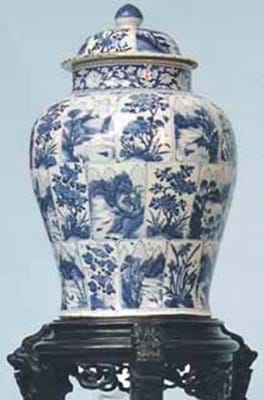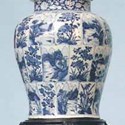The result, nevertheless, was much the same. Although the lamp lacked two of its ten gold Favrile glass bell-drop shades, which naturally held back bidding to some extent, it still generated US and UK private and trade interest and sold towards the upper end of the estimate to an American buyer at £8500.
An even more unusual offering at the sale was an Ancient Egyptian alabaster canopic jar used in the mummifying process - although more than one old Led Zep fan spotted the Stairway To Heaven link.
Entered by a local private vendor, together with a letter from the British Museum dating it to around 400BC, the jar would originally have contained the deceased's organs, and the lid was modelled with the god Hapi, a baboon and symbol of the North Kingdom.
"It is rare to find such a jar in such excellent condition and specialists who viewed it intimated it was the first canopic jar they had seen at a provincial auction for ten years," said Dreweatt Neate specialist Dan Bray.
Thanks to its condition and the BM letter, a specialist buyer went to £5500 for ownership.
Also of note was a Chinese Kangxi period (1666-1722) blue and white baluster jar and domed cover painted with alternating panels of peony, prunus, foliage and landscapes and entered together with a later hardwood stand. Its £1500-2000 estimate took into account restoration to the cover, a hair crack to the neck and a firing crack on the foot, but demand for well-executed, fresh-to-market, early 18th century Chinese porcelain saw this large 2ft 7in (79cm) vase sell at £5100 to one of five specialist London dealers bidding on the telephone.
A Japanese dealer in the room secured a pair of Japanese bronze Meiji period (1868-1912) samurai figural incense burners at £2000.
Headlining the silver was an extensive 153-piece Victorian part-canteen in the unusual Elizabethan pattern. Although it would originally have comprised 48 place settings, for the most part there were at least 12 complete settings and this, coupled with its pattern, saw it fetch £7900 from a London dealer.
Healthy prices for these highlights helped counterbalance the fairly lacklustre furniture section which suffered, in part, as a result of vendor-led estimates.
"Vendors' expectations are often not in line with the market," said Mr Bray. "Two or three years ago they would have paid perhaps twice the money that a piece of furniture would now realistically fetch."
Leading the section was a pair of mid-19th century kingwood and ormolu bonheurs du jour which sold at £3600.
Stairways to heaven, via a Led Zeppelin lamp or a Pharaonic jar
AN early 20th century Tiffany Favrile ten-light lamp was an unusual consignment for a provincial auction house. The market for Tiffany is largely based in America and even the major London rooms tend to sell their best consignments through their New York rooms. However, the family of the late Peter Grant, former manager of the legendary rock group Led Zeppelin, live locally and put his lamp into Dreweatt Neate Tunbridge Wells Saleroom's (15% buyer's premium) September 3 sale.








